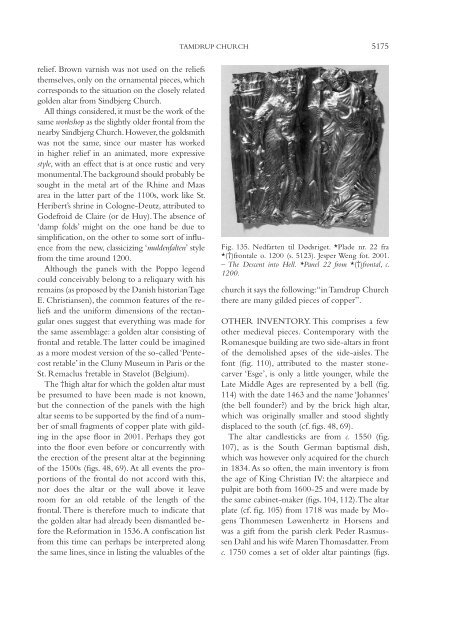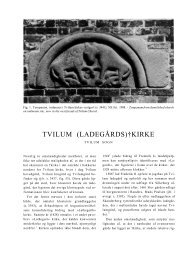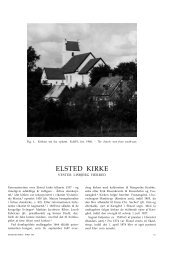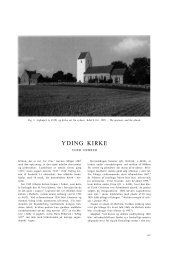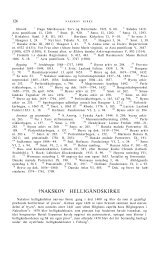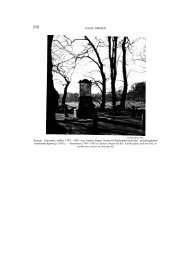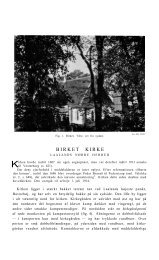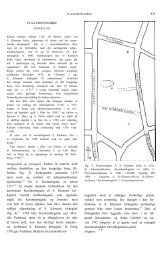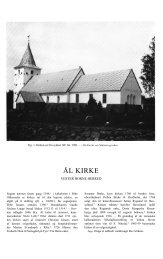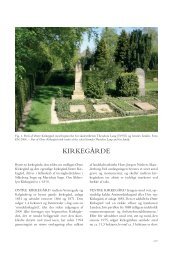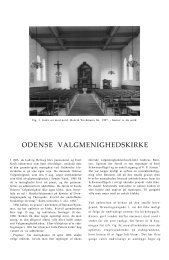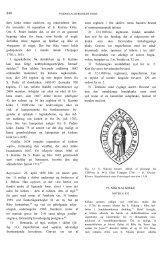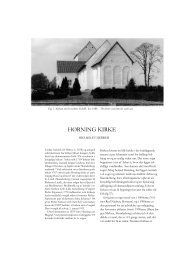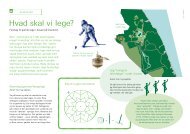You also want an ePaper? Increase the reach of your titles
YUMPU automatically turns print PDFs into web optimized ePapers that Google loves.
elief. Brown varnish was not used on the reliefs<br />
themselves, only on the ornamental pieces, which<br />
corresponds to the situation on the closely related<br />
golden altar from Sindbjerg Church.<br />
All things considered, it must be the work of the<br />
same workshop as the slightly older frontal from the<br />
nearby Sindbjerg Church. However, the goldsmith<br />
was not the same, since our master has worked<br />
in higher relief in an animated, more expressive<br />
style, with an effect that is at once rustic and very<br />
monumental. The background should probably be<br />
sought in the metal art of the Rhine and Maas<br />
area in the latter part of the 1100s, work like St.<br />
Heribert’s shrine in CologneDeutz, attributed to<br />
Godefroid de Claire (or de Huy). The absence of<br />
‘damp folds’ might on the one hand be due to<br />
simplification, on the other to some sort of influence<br />
from the new, classicizing ‘muldenfalten’ style<br />
from the time around 1200.<br />
Although the panels with the Poppo legend<br />
could conceivably belong to a reliquary with his<br />
remains (as proposed by the Danish historian Tage<br />
E. Christiansen), the common features of the reliefs<br />
and the uniform dimensions of the rectangular<br />
ones suggest that everything was made for<br />
the same assemblage: a golden altar consisting of<br />
frontal and retable. The latter could be imagined<br />
as a more modest version of the socalled ‘Pentecost<br />
retable’ in the Cluny Museum in Paris or the<br />
St. Remaclus †retable in Stavelot (Belgium).<br />
The †high altar for which the golden altar must<br />
be presumed to have been made is not known,<br />
but the connection of the panels with the high<br />
altar seems to be supported by the find of a number<br />
of small fragments of copper plate with gilding<br />
in the apse floor in 2001. Perhaps they got<br />
into the floor even before or concurrently with<br />
the erection of the present altar at the beginning<br />
of the 1500s (figs. 48, 69). At all events the proportions<br />
of the frontal do not accord with this,<br />
nor does the altar or the wall above it leave<br />
room for an old retable of the length of the<br />
frontal. There is therefore much to indicate that<br />
the golden altar had already been dismantled before<br />
the Reformation in 1536. A confiscation list<br />
from this time can perhaps be interpreted along<br />
the same lines, since in listing the valuables of the<br />
<strong>TAMDRUP</strong> CHURCH<br />
5175<br />
Fig. 135. Nedfarten til Dødsriget. *Plade nr. 22 fra<br />
*(†)frontale o. 1200 (s. 5123). Jesper Weng fot. 2001.<br />
– The Descent into Hell. *Panel 22 from *(†)frontal, c.<br />
1200.<br />
church it says the following: “in Tamdrup Church<br />
there are many gilded pieces of copper”.<br />
OTHER INVENTORY. This comprises a few<br />
other medieval pieces. Contemporary with the<br />
Romanesque building are two sidealtars in front<br />
of the demolished apses of the sideaisles. The<br />
font (fig. 110), attributed to the master stonecarver<br />
‘Esge’, is only a little younger, while the<br />
Late Middle Ages are represented by a bell (fig.<br />
114) with the date 1463 and the name ‘Johannes’<br />
(the bell founder?) and by the brick high altar,<br />
which was originally smaller and stood slightly<br />
displaced to the south (cf. figs. 48, 69).<br />
The altar candlesticks are from c. 1550 (fig.<br />
107), as is the South German baptismal dish,<br />
which was however only acquired for the church<br />
in 1834. As so often, the main inventory is from<br />
the age of King Christian IV: the altarpiece and<br />
pulpit are both from 160025 and were made by<br />
the same cabinetmaker (figs. 104, 112). The altar<br />
plate (cf. fig. 105) from 1718 was made by Mogens<br />
Thommesen Løwenhertz in Horsens and<br />
was a gift from the parish clerk Peder Rasmussen<br />
Dahl and his wife Maren Thomasdatter. From<br />
c. 1750 comes a set of older altar paintings (figs.


